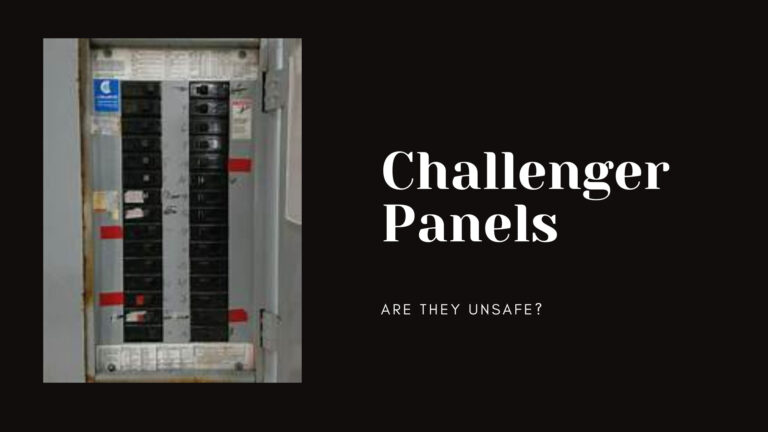In this post, we’ll dive into the safety issues associated with certain Challenger panels and what you should do if you find one in your home.
The History of Challenger Electrical Panels
Challenger electrical panels were installed in many homes throughout the 1980s and 1990s. They were widely used because of their affordability and availability. However, over time, these panels became notorious for a number of electrical issues that could lead to unsafe conditions, including overheating and even fire risks.
While not every Challenger panel is unsafe, certain models and breakers within the Challenger series are known to have serious defects.
Why Are Some Challenger Panels Unsafe?
The main issue with unsafe Challenger panels lies in the breakers. In certain models, the breakers have been reported to fail to trip when overloaded. Normally, a breaker “trips” or shuts off when there’s too much current flowing through the circuit, which helps to prevent overheating and fires. However, when a breaker fails to trip, it can result in overheating, leading to electrical fires.
Other reported problems include faulty connections and loose bus bars (the part of the panel that distributes power to the breakers), which also contribute to overheating risks.
What Challenger Electric Panels Are Unsafe?
Here is a list of potentially unsafe Challenger electrical panels and breakers that have been associated with safety concerns, based on inspections, industry reports, and recall information:
-
Challenger load centers (1980s–early 1990s)
-
Challenger panels with type A, A1, and B breakers
-
Challenger panels using BR-series breakers (pre-Eaton)
-
Challenger panels rebranded for other manufacturers
-
Challenger panels with CA-series breakers involved in the 1994 CPSC recall
Identifying a Problematic Challenger Panel
If you live in a home that was built or had its electrical system updated between the 1980s and mid-1990s, you may have a Challenger panel. Here’s how you can identify it:
- Look at your electrical panel and see if there’s a label with the Challenger name or logo. Challenger breakers are also marked with the brand.
- If your panel has a label with Zinsco or GTE-Sylvania branding, this may also indicate a risk, as Challenger panels were often manufactured or associated with these brands.
The Risks of Keeping an Outdated Challenger Electric Panel
Homeowners with older Challenger panels face several risks. The most significant is the potential for a breaker not to trip when it should, increasing the chance of electrical fires. In fact, some insurance companies may deny coverage or require replacement of the panel before offering a policy due to these safety risks.
In addition, outdated Challenger panels are less efficient than modern panels. If you’ve upgraded your home’s electrical appliances or added more devices, these older panels may not be able to handle the increased electrical load properly, which can lead to further safety concerns.
You may also be interested in: What Is a Panel Change and How Do I Know if I Need One?
What Should You Do if You Have a Challenger Circuit Breaker Panel?
If you suspect that your home has a Challenger panel, it’s crucial to take action:
-
Schedule an Inspection – Contact a licensed electrician to perform an inspection of your panel. They can determine whether your Challenger panel is among the unsafe models and evaluate its overall condition.
-
Consider Replacement – If your panel is identified as a potential fire hazard, replacement is the safest option. Modern electrical panels are designed to handle higher loads and are far more reliable. Read our blog to learn more about the cost of an electric panel update.
-
Consult with Your Insurance Company – Some insurance companies may require the replacement of a Challenger panel before continuing or offering coverage. It’s a good idea to check with your provider to see what their policy is regarding older electrical panels.
Don’t Take Chances with Electrical Safety
Electrical panels are the heart of your home’s power system, and while they may not be something you think about often, they’re vital to your safety. If your home has a Challenger electrical panel, it’s essential to be proactive. Contact a licensed electrician to evaluate your panel, and if needed, replace it with a safer, modern option. Your home’s electrical system is one area where it pays to be cautious and make the necessary upgrades to ensure the safety of your household.
By staying informed and taking action, you can protect your home from potential electrical hazards and enjoy peace of mind knowing your system is up to date.
You may also be interested in: How One Brandon, Florida Homeowner Used Financing to Replace a Challenger Panel and Saved His Insurance.
Challenger Electrical Panel FAQ
Is a Challenger electrical panel safe?
Not always. Older Challenger panels (especially from the 1980s–90s) are known to have breakers that may overheat or fail to trip, posing a fire risk.
Are Challenger electrical panels still made?
No. Challenger panels were discontinued after Eaton acquired the brand in the 1990s. Eaton-branded panels and breakers are still available.
How much does it cost to replace a Challenger electrical panel?
Replacement typically costs between $1,500 and $3,000, depending on the panel size, location, and local labor rates.
Why were Challenger panels recalled?
Some Challenger breakers (not the entire panel line) were recalled in 1994 because they could fail to trip during electrical faults, increasing the risk of fire.
Do I have to replace my Challenger electrical panel?
Not legally, but replacement is strongly recommended if your panel has original Challenger breakers, shows signs of damage, or hasn’t been inspected recently.

